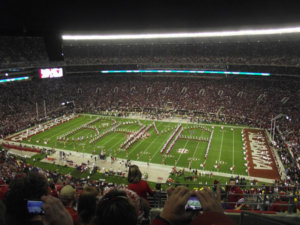Branding the American College Experience
Published on December 20, 2017, at 7:20 a.m.
by Caitlin Heffley.
For most, college can be summed up in a few short phrases, words or images. Perhaps the idea is a chant from a Greek organization to which one belonged, or a vision of an old dorm room or apartment. Maybe it is the name of a favorite bar, restaurant or coffee shop. It might be sleepless nights in the library, study groups and midnight trips to the nearest fast food joint.
From the outside looking in, one might depict college in the United States as the media has. Football games and rowdy parties accompanied by free-flowing alcohol and binge drinking make up just some of the imagery the public consumes through movies, television, books and music.
The traditional college experience brand is comprised of all of the above, but are these concepts universally held? If so, is this image of higher education one that the United States desires to portray?
The media’s influence
In its simplest form, a brand is “what your prospect thinks of when he or she hears your brand name,” according to Forbes.com. “But your brand exists only in someone’s mind.”

The challenge arises in categorizing and characterizing something so broad and unpredictable, such as college, and wrapping it up nicely into a box with a bow. Nevertheless, the media has attempted to do so by forming its own brand of the American college experience.
American-produced media flourishes in other countries, resulting in limited exposure for consumers in these countries to the realities versus the misconceptions of American university culture; however, an astonishing amount of foreign students still choose to study in the United States every year.
According to an article from The Atlantic, the influx of international students pursuing higher education in the United States reached nearly 1 million in 2015 and continues to grow. Clearly the media’s portrayal is not deterring prospective students. On the contrary, could it be that this college brand is actually enticing them?
The outsider’s perspective
“It’s the American dream,” said Berni Hausleitner, an exchange student at The University of Alabama from Arnstorf, Germany. “I wanted to come experience what I had seen in the movies.”

Hausleitner spoke about his amazement with the size of UA, the amenities it offers and the grandeur of the football program. He noted that school in Germany is much more simplistic, with only about 5,000 students at his school — University Esslingen of Applied Sciences — and only three buildings making up the campus.
It would be safe to assume that this media-created brand is in fact luring international students who, like Hausleitner, are fascinated by its relatively excessive nature. What’s more, it appears that this glamorized ideal did not change for the German exchange student once on campus.
“It’s exactly like [the movies] — especially the fraternity parties, pledges and things like that. … But I’d have to say I prefer studying here at the moment. There are so many people and so many places to go,” Hausleitner said.
The insider’s intent
On an opposite end of the spectrum, administrators at American universities seem to be attempting to create a fairly different picture of what it’s like to attend college in America, focusing on integrating international students into the positive elements of American culture.
 “Part of my job is to help [international] students register for courses, and organize cultural events for them throughout their stay,” said Jonny Porter, an adviser in the Education Abroad department at The University of Alabama.
“Part of my job is to help [international] students register for courses, and organize cultural events for them throughout their stay,” said Jonny Porter, an adviser in the Education Abroad department at The University of Alabama.
Porter also emphasized the aesthetic component of colleges in America as a major selling point, especially at UA. As a four-year, state university, it is a textbook example of a typical American educational institution.
“I think [UA] truly represents the American university as [international students] see it in their minds … a beautiful, green campus, a strong football team and a large population,” Porter said. “We have many of the qualities they are seeking out for their American experience.”
According to Porter, the Education Abroad program introduces the students to American norms within the brand of the college experience, such as shopping trips to Target for school and housing supplies. Whatever the image that these university programs are selling, it seems to be working.
After their experience here, “students return to the university. Some have completed their degrees and come back for graduate school, while others simply transferred after studying abroad,” Porter said.
The brand
In essence, the American college experience is not easily defined. The brand is nearly as diverse and complex as the nation from which it derives, but perhaps this is why students like Berni Hausleitner enjoy it so much.
As he would put it, the American college experience is “the good kind of crazy.”




